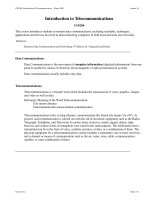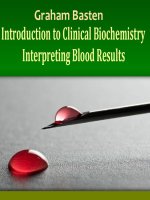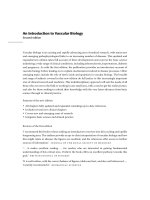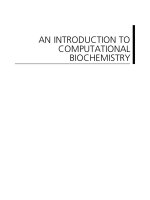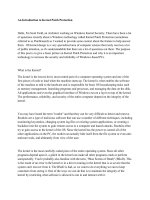INtroduction to clinical biochemistry
Bạn đang xem bản rút gọn của tài liệu. Xem và tải ngay bản đầy đủ của tài liệu tại đây (3.97 MB, 57 trang )
DR. GRAHAM BASTEN
INTRODUCTION TO CLINICAL
BIOCHEMISTRY
INTERPRETING BLOOD RESULTS
DOWNLOAD FREE TEXTBOOKS AT
BOOKBOON.COM
NO REGISTRATION NEEDED
Dr. Graham Bast en
I nt roduct ion t o Clinical Biochem ist ry:
I nt erpret ing Blood Result s
Download free books at BookBooN.com
2
I nt roduct ion t o Clinical Biochem ist ry: I nt erpret ing Blood Result s
© 2010 Dr. Graham Bast en & Vent us Publishing ApS
I SBN 978- 87- 7681- 673- 5
Download free books at BookBooN.com
3
Introduction to Clinical Biochemistry:
Interpreting Blood Results
Contents
Cont ent s
About the Author
1.
1.1
1.2
1.2.1
1.3
1.4
1.4.1
1.4.1
1.4.1
1.5
1.6
1.7
1.7.1
1.7.2
8
Professional Qualifications and Memberships
10
Introduction to Clinical Biochemistry: Interpreting Blood Results
11
Preface
11
Laboratory tests: Interpreting Results
A typical blood sciences service
Variables that may affect a result: Analytical
Analytical sensitivity and specificity
Standards
Quality Control: Within batch, between batch, external
Within batch variation
Between batch variation
External quality control
Control Plots
Precision, Accuracy, Bias
Variables that will affect a result: Physiological
Blood collection and storage techniques
The difference between plasma and serum
12
12
12
12
13
14
14
15
15
15
17
17
18
18
Please click the advert
WHAT‘S MISSING IN THIS EQUATION?
You could be one of our future talents
MAERSK INTERNATIONAL TECHNOLOGY & SCIENCE PROGRAMME
Are you about to graduate as an engineer or geoscientist? Or have you already graduated?
If so, there may be an exciting future for you with A.P. Moller - Maersk.
www.maersk.com/mitas
Download free books at BookBooN.com
4
Introduction to Clinical Biochemistry:
Interpreting Blood Results
Contents
A haemolysed sample.
Reference ranges
Clinical sensitivity and specificity
Summary
19
20
21
23
2.
2.1
Overview of tests
Summary
24
26
3.
3.1
3.1.1
3.1.2
3.1.3
3.1.4
3.2
3.2.1
3.2.2
3.2.3
3.2.4
3.2.5
3.2.7
3.3
3.3.1
3.3.2
3.3.3
The blood cells and liquid component: Full Blood Count (FBCs)
Red Blood Cell Indices
Red Blood Cell Number
Haemoglobin
Mean Cell Volume
Haematocrit (HCT)
White Blood Cell Indices
White Blood Cell Number
White Cell Differential
Neutrophils
Lymphocytes
Basophils and Eosinophils
Blast Atypical cells
Clotting Indices
Platelet Number
Prothrombin Time
Partial thromboplastin time
27
28
28
29
30
31
31
31
31
32
32
33
33
33
33
34
34
Please click the advert
1.7.3
1.7.4
1.7.6
1.8
Download free books at BookBooN.com
5
Please click the advert
Introduction to Clinical Biochemistry:
Interpreting Blood Results
Contents
3.3.4
3.3.5
3.4
International Normalised Ratio
D-Dimers
Summary
34
34
35
4.
4.1
4.2
4.3
4.4
Autoimmune and inflammation
Inflammation and CRP
Plasma Viscosity
Erythrocyte Sedimentation Rate
The inflammation trilogy
36
38
39
39
39
5.
5.1
5.1.1
5.1.2
5.1.3
5.1.4
5.1.5
5.1.5
5.2
5.3
5.3.1
5.3.2
5.3.3
5.3.4
5.4
Liver function test (LFTs) and Enzymes
Enzymes
Measuring an enzyme
Activation energy
Factors which affect enzyme rate
Factors which inhibit enzymes
Extracellular vs. Intracellular
Isoenzymes
Bilirubin
Liver Enzymes
Aspartate aminotransferase (AST)
Alanine Aminotransferase (ALT)
Gamma-glutamyl transferase (GGT)
Alkaline phosphatase (ALP)
Summary
41
42
42
43
43
43
44
45
45
46
46
46
46
47
47
Sign up for Vestas
Winnovation
Challenge now
- and win a trip around the world
Read more at vestas.com/winnovation
Download free books at BookBooN.com
6
Introduction to Clinical Biochemistry:
Interpreting Blood Results
Contents
Kidney function tests and electrolytes (U&Es)
Electrolytes
Sodium (Na)
Potassium (K)
Urea and Creatinine
Glomerular filtration rate (GFR)
Uric acid and gout
Summary
48
49
49
49
49
50
50
50
7.
7.1
7.2
7.3
7.3.1
7.3.2
7.3.3
7.3.4
The bone and calcium (bone profile)
Corrected calcium
Calcium control
Bone diseases
Osteoporosis
Paget’s disease
Osteomalacia and rickets
Differentiating between bone diseases
51
51
52
53
53
54
54
54
8.
Summary
56
Please click the advert
6.
6.1
6.1.1
6.1.2
6.2
6.3
6.4
6.5
www.job.oticon.dk
Download free books at BookBooN.com
7
Introduction to Clinical Biochemistry:
Interpreting Blood Results
About the Author
About t he Aut hor
Dr. Graham Basten
De Montfort University
Associate Head of School
School of Allied Health Sciences
Faculty of Health & Life Sciences
Room H1M-2 Hawthorn Building
Leicester LE1 9BH
E-mail:
Phone: 0116 207 8639
Fax: 0116 250 6411
Website: />Twitter: />Academic Blog: />Research Blog: />Short Biography
Dr Graham Basten is Associate Head of the School of Allied Health Sciences at De Montfort University
(UK). He holds a PhD from the UK government’s Institute of Food Research and has researched and
lectured extensively over the past 10 years on clinical biochemistry, nutrition and folate at the Universities
of Sheffield and Nottingham (UK). He is a De Montfort University Teacher Fellow and has been
nominated for the Vice Chancellor’s Distinguished Teaching Award. As a senior lecturer in Clinical
Chemistry, and as leader of the undergraduate Projects module, this expertise and experience is transferred
to the concise introductory textbooks written for Book Boon.
Download free books at BookBooN.com
8
Introduction to Clinical Biochemistry:
Interpreting Blood Results
About the Author
Select research publications
1. Blood folate status and expression of proteins involved in immune function, inflammation,
and coagulation: biochemical and proteomic changes in the plasma of humans in response
to long-term synthetic folic acid supplementation. Duthie SJ, Horgan G, de Roos B,
Rucklidge G, Reid M, Duncan G, Pirie L, Basten GP, Powers HJ. J Proteome Res. 2010 Apr
5;9(4):1941-50
2. Sensitivity of markers of DNA stability and DNA repair activity to folate supplementation in
healthy volunteers. Basten GP, Duthie SJ, Pirie L, Vaughan N, Hill MH, Powers HJ. Br J Cancer.
2006 Jun 19;94(12):1942-7. Epub 2006 May 30
3. Associations between two common variants C677T and A1298C in the methylenetetrahydrofolate
reductase gene and measures of folate metabolism and DNA stability (strand breaks,
misincorporated uracil, and DNA methylation status) in human lymphocytes in vivo. Narayanan S,
McConnell J, Little J, Sharp L, Piyathilake CJ, Powers H, Basten G, Duthie SJ. Cancer Epidemiol
Biomarkers Prev. 2004 Sep;13(9):1436-43
4. Effect of folic Acid supplementation on the folate status of buccal mucosa and lymphocytes.
Basten GP, Hill MH, Duthie SJ, Powers HJ. Cancer Epidemiol Biomarkers Prev. 2004
Jul;13(7):1244-9
Download free books at BookBooN.com
9
Introduction to Clinical Biochemistry:
Interpreting Blood Results
Professional Qualifi cations and Memberships
Professional Qualificat ions and Mem berships
Fellow of the Higher Education Academy (HEA) and National Teacher Fellow Reviewer
De Montfort University Teacher Fellow
Member of the Institute of Biomedical Science
Member of the Phytochemical Society of Europe
Science Technology STEM Ambassador
Member and De Montfort University (DMU) Representative for the Society of Biology
Member of the Sherwood Forest Hospitals NHS Trust
Download free books at BookBooN.com
10
Introduction to Clinical Biochemistry:
Interpreting Blood Results
Preface
I nt roduct ion t o Clinical Biochem ist ry:
I nt erpret ing Blood Result s
Preface
This book is primarily aimed at undergraduate students reading medicine, nursing and midwifery and
subjects allied to health. It will also be useful to professionals undergoing continuing professional
development (CPD) or changing to an extended role who require a background covering physiology and
pathology for haematology and biochemistry. Since the book uses “example boxes” to explain complex
terms in lay language, it should also be accessible to patients and people with a non-clinical background
but an interest in the subject. To facilitate this, each chapter has an introductory paragraph guiding the
reader to the example boxes if needed and a summary section.
Chapter 1 examines how to interpret results, with the remaining broadly representing a section of the body
or a disease type with chapter 9 as a summary. This should enable a read from cover to cover or equally as
a reference with each chapter independent. As this book is an introduction to the area, you may be inspired
for further training and reading. There are many excellent resources online, too many to list here, although
I would recommend starting with your countries’ primary care provider organisation, respected charities,
reputable training companies and higher education institutes for further information.
Study with the textbook using key concepts (these are the headings and sub headings). List the key
concepts and attempt to write a few words about each section, and then refer back to the text book.
Expert boxes are provided as cues for further reading, as this text is an introductory overview it is not
conducive to all readers to cover all aspects in considerable detail.
Example boxes will provide worked examples or case studies
Disclaimer
Reference ranges, normal, abnormal and cut-off values are provided as examples to explain a term or
disease setting, these are not transferable to the reader’s own setting. Similarly, definitive diagnosis,
prescribing, treatment, monitoring times are excluded; the reader should seek this information from their
primary care provider or trusted sources. Case studies are used throughout but should not be used as the
basis for a diagnosis. Neither the author nor the publisher accepts any liability for the reader using the
information in the book inappropriately.
Download free books at BookBooN.com
11
Introduction to Clinical Biochemistry:
Interpreting Blood Results
Laboratory tests: Interpreting Results
1. Laborat ory t est s: I nt erpret ing Result s
This chapter introduces the key steps in ensuring that the blood result is as accurate as possible. Whilst
true that in most modern hospitals much of the calculations in this chapter will be automated and produced
by computer programmes, an understanding of the basic principles is to be encouraged. The non-clinical
reader may find the section about reference ranges most useful.
1.1 A t ypical blood sciences service
Clinical chemistry, chemical pathology and clinical biochemistry are names given to the study of
biochemical events or parameters in the body. Increasingly and intuitively, this study has merged with
certain aspects of haematology (blood cells and liquid). This has created a new field called “blood
sciences” which encompasses sections of both disciplines to create a more logical service to users.
Typically a blood science service will have a laboratory manager who will oversee the production of
reliable results, and will usually be state registered. Logistically, there will be areas for sample reception,
analysis, reporting data and storage of material.
1.2 Variables t hat m ay affect a result : Analyt ical
There are two factors can affect the result of a blood test, analytical or physiological. Analytical error is caused by
the service, typically the machine or process which produces the result. Physiological error is caused by people,
typically how the blood is collected, whether the patient was fasted or taking medication.
1.2.1 Analyt ical sensit ivit y and specificit y
Each blood test will have an experimental technique to produce the result. Confusingly, two sets of
sensitivity and specificity exist in blood sciences; they have total different meanings and refer to either
analytical and physiological (or diagnostic) measures.
Analytical sensitivity refers to the detection limit of the experiment. This is the smallest amount of
material of interest that the experiment can detect. As technology has developed it is increasingly easier to
measure smaller quantities of material, although at small levels the accuracy and precision may be lower
and this can be measured using quality control.
Example: Prostatic Cancer (Cancer of the prostate): A test for this is prostate specific antigen (PSA).
PSA increases with the severity of the disease but is also elevated in the early stages, if the method could
not detect low levels of PSA then early diagnosis would not be possible.
Download free books at BookBooN.com
12
Introduction to Clinical Biochemistry:
Interpreting Blood Results
Laboratory tests: Interpreting Results
Analytical specificity refers to whether any other similar chemicals interfere with the test.
Example: Insulin levels may be measured in diabetic management, and it is beneficial to have a test that
can differentiate between insulin and proinsulin to avoid an artificially elevated result.
1.3 St andards
Please click the advert
Most tests will have a type of standard to measure quality and ensure the result is as accurate as possible.
There are usually two types either primary or secondary. A primary standard is of a known quantity and is
often produced externally with certification, they are used to characterise the upper and lower parameters
or sensitivity of the test. Often labelled as high, low, calibrators, controls they can also be used to calibrate
on-board software of automated analysers. They have a clear advantage in that they can be stored long
term and provide a known amount or concentration; a clear disadvantage is that they are usually in a
“pure” matrix such as saline or a buffer. I’m confident in declaring that there is no human alive with blood
constituted from 100% saline. Hence the need for secondary standards which are usually samples of
plasma, serum or whole blood to ensure that test is suitable and consistent in the chosen matrix. This
forms the basis for within and between batch variation (see chapter 1.4)
Download free books at BookBooN.com
13
Introduction to Clinical Biochemistry:
Interpreting Blood Results
Laboratory tests: Interpreting Results
Example: Red cell folate (RCF) primary standards in saline buffer were used to calibrate the machine and
create a calibration curve. Red cells from a single volunteer were obtained and lysed (broken open) and
RCF was measured many times (several replicates) in one attempt giving a mean (average) RCF of
300nM (secondary standard). Subsequent measures of RCF in the service would include the primary
standard but also the secondary standard alongside various patient samples sent for RCF testing.
1.4 Qualit y Cont rol: Wit hin bat ch, bet w een bat ch, ext ernal
Each blood test result produced by an accredited laboratory will have quality control procedures in place
to ensure that inevitable variations in machine, staff, and temperature do not affect the result.
1.4.1 Wit hin bat ch var iat ion
This is used to evaluate how good the technique is at giving the same result for identical samples in one
attempt. This method often identifies whether a machine has bias towards a certain location on the rotor.
Figure 1.1 shows a typical rotor which has 11 samples ready to analyse. H and L are primary standards
(see chapter 1.3) and each yellow circle represents the same sample in replicate.
With the results from the experiment we can calculate the mean and standard deviation (SD) of the 9
identical yellow samples. Using the mean and standard deviation we can calculate the %Coefficient of
Variance (CV)= ((SD /Mean)x100). This data is used to create the Y-Axis of a control plot (see 1.5). A
common misconception is that a low CV is by default better than a higher one. The most important thing
is that to consider is if the CV changes.
Figure 1.1: Within batch variation
Download free books at BookBooN.com
14
Introduction to Clinical Biochemistry:
Interpreting Blood Results
Laboratory tests: Interpreting Results
1.4.1 Bet w een bat ch var iat ion
This is used to evaluate how good the technique is at giving the same result on separate attempts. It is
used to evaluate for example, if the machine or indeed a different operator will give a different result at a
different time. Figure 1.2 shows the next two rotors done after our within batch test. They too have H and
L standards (primary) and the same yellow sample we used for within batch (secondary) and it is this data
(either from the primary, secondary, or both) which is used to create the X-Axis of a control plot (see 1.5)
However, we also have the green sample which are different patient’s samples and the control plot will
inform the service if the green results are suitable to be released as accurate..
Figure 1.2: Between batch variation
1.4.1 Ext ernal qualit y cont rol
This is used to evaluate if you get a different result if the test is done at a different site. Typically, a
national organisation will send the same sample to different laboratories accredited to produce blood
results and measure how similar the returned result is.
1.5 Cont rol Plot s
There are two commonly used of control plots, either Levey Jennings or Westgard and both inform the service of
the accuracy of the test over time. Excellent online resources for both these plots exist, accessible by any good
search engine, and will provide further reading. They usually have a range of the mean plus or minus 3SD
(standard deviation) which on normally distributed data is 99.7% confidence. Test results for a patient sample
which fall outside of this range are to be considered for rejection. The plots also inform the test is over or under
reporting results over time.
Download free books at BookBooN.com
15
Introduction to Clinical Biochemistry:
Interpreting Blood Results
Laboratory tests: Interpreting Results
Example: 500 samples within batch cholesterol secondary standards were measured. The mean was 200 mg/dL
and the SD was 4. Therefore, 2SD = 8, 3SD = 12 and so on. On the Y-axis plot the mean +3SD through to the
mean -3SD, so the mean is 200, the mean plus 3SD is 212 and the mean minus 3SD is 188 (Figure1. 3)
Figure 1.3: Example of a control plot.
Please click the advert
On the Y-axis is the mean plus and minus 3 SD determined by the within batch, on the X-axis is the mean value
for each between batch test. The red dot is a mean value which is outside the 3SD range and may be considered
for rejection. Each blue dot (x10) is the mean value of the between batch over 10 days, a blue dot per day, this
shows that this test is under reporting. Think about what a test that over reported may look like?
In Paris or Online
International programs taught by professors and professionals from all over the world
BBA in Global Business
MBA in International Management / International Marketing
DBA in International Business / International Management
MA in International Education
MA in Cross-Cultural Communication
MA in Foreign Languages
Innovative – Practical – Flexible – Affordable
Visit: www.HorizonsUniversity.org
Write:
Call: 01.42.77.20.66
www.HorizonsUniversity.org
Download free books at BookBooN.com
16
Introduction to Clinical Biochemistry:
Interpreting Blood Results
Laboratory tests: Interpreting Results
1.6 Precision, Accuracy, Bias
Precision, Accuracy, Bias are terms used to describe certain parameters of the test. Precision is how close
repeated measures of the same sample lie, accuracy is how close the value reported is to the true value and
bias describes variables which may affect precision and accuracy and lead to over and under reporting or
large random background changes.
A helpful analogy is that of Robin Hood who has 5 arrows and must hit the middle of the red centre bull’s
eye to win the pageant and release Maid Marian (FIG. 1.4) he needs to be accurate and precise, a reason
for not being could be “bias” such as a cross wind, bent arrows, too much wine or mead!
Figure 1.4: Robin Hood at the pageant
1.7 Variables t hat will affect a result : Physiological
Sections 1.2 to 1.6 looked at how the machinery and experimental method (analytical) can produce errors
in the results. In the remainder of the chapter issues caused by people will be explored. Such as, how
blood is collected and stored, the difference between plasma and serum, using reference ranges and
clinical sensitivity and specificity.
Download free books at BookBooN.com
17
Introduction to Clinical Biochemistry:
Interpreting Blood Results
Laboratory tests: Interpreting Results
1.7.1 Blood collect ion and st orage t echniques
Tourniquets are often used to collect blood samples as they block venous return and cause dilatation enabling
identification of entry points. However, due to this phenomenon typically, for each minute of use due to loss of
water and electrolytes from plasma, plasma protein increases by up to 1%. The stasis of blood flow can produce
different metabolic products such as lactate and if the patient is asked to clench their fist this may cause an
artifactual hyperkalemia (elevated potassium levels). Clearly these disadvantages do not justify the non-use of
tourniquets but may be worth considering if results appear unlikely based on symptoms or unreliable.
Caution should be given if blood is being taken near an intravenous entry site as to not in effect be taking
a sample from the saline or glucose bag itself, a highly unlikely plasma glucose of over 50,000 mg/mL was
measured in such a patient!
Other problems include poor patient identification, samples taking more than 72 hours to be transported to
the service, incorrect temperature or not protected from light. To reduce this error each test will have a
specific blood collection protocol.
1.7.2 The difference bet ween plasm a and serum
Serum is thought to be a derivative word for “whey” as in “curds and whey” which are the products
formed when milk is allowed to clot. The whey is the liquid component whilst the curds are the solid parts.
If blood is allowed to clot the liquid component is therefore called serum, if blood is prevented from
clotting then the liquid component is called plasma (FIG. 1.6).
Figure 1.6: The difference between plasma and serum
Download free books at BookBooN.com
18
Introduction to Clinical Biochemistry:
Interpreting Blood Results
Laboratory tests: Interpreting Results
The main disadvantage of using serum is that the blood has already participated in clotting. In other words,
a series of metabolic processes have occurred after the sample was collected but before the sample was
measured and this can lead to error in measures like potassium, phosphate, magnesium, aspartate
aminotransferase and lactate dehydrogenase. As we will see in alter chapters these are key measures of
acute and chronic disease. The advantages of serum is that it can be used to measure constituents which
would be destroyed or compromised by the anticoagulant chemicals used in the preparation of plasma
samples.
The main disadvantages of using plasma (blood which has not clotted due to the addition of anticoagulants)
is the anticoagulants can interfere with certain analytical methods or change the concentration of the
constituents to be measured.
The advantages of using plasma samples include “cleaner” samples which have not undergone the clotting
process, time saving and a higher yield (up to 20 %)
1.7.3 A haem olysed sam ple.
If following centrifugation the plasma or serum looks reddish rather than straw yellow, it is likely the
sample has haemolysed (FIG. 1.7). In a haemolysed sample some of the red blood cells have lysed
(broken open) and their contents have now contaminated the plasma or serum sample. This will cause
error in reporting amongst others elevated potassium, magnesium and phosphate. Some analytical
methods may be able to negate the effect of the haemolysed sample. Common causes of a haemolysed
sample are collection needle gauge too narrow, over vigorous shaking of the sample, underlying
haematological disorder, red cells isolated for storage and then stored in water or a non isotonic solution
and over physical dispensing of blood from hypodermic syringe to collection tubes.
Figure 1.7: A haemolysed sample
Download free books at BookBooN.com
19
Introduction to Clinical Biochemistry:
Interpreting Blood Results
Laboratory tests: Interpreting Results
1.7.4 Reference ranges
Most people are comfortable with the idea of reference ranges, but what do actually tell us, or rather don’t tell
us? To create a reference range a number (usually over 120) of volunteers are matched for factors (table 1) and
the analyte is measured. Firstly, most ranges have a 95% confidence which means that the top 2.5% of values
and the bottom 2% of values are omitted, so it is possible to be healthy but outside the reference range, you are
just at the very top or the very bottom which aren’t shown (see 1.7.6). Secondly, you should use ranges from
unvalidated sources with great care as ranges can vary with age and sex for example.
Age
Posture
Blood group
Race
Circadian variation
Sex
Diet
Menstrual cycle
Ethnic background
Pregnancy
Exercise
Time of day
Fasted
Tobacco 2ndary
Geographical location
Table 1 shows common attributes which are matched to create, or can affect a reference range.
Turning a challenge into a learning curve.
Just another day at the office for a high performer.
Please click the advert
Accenture Boot Camp – your toughest test yet
Choose Accenture for a career where the variety of opportunities and challenges allows you to make a
difference every day. A place where you can develop your potential and grow professionally, working
alongside talented colleagues. The only place where you can learn from our unrivalled experience, while
helping our global clients achieve high performance. If this is your idea of a typical working day, then
Accenture is the place to be.
It all starts at Boot Camp. It’s 48 hours
that will stimulate your mind and
enhance your career prospects. You’ll
spend time with other students, top
Accenture Consultants and special
guests. An inspirational two days
packed with intellectual challenges
and activities designed to let you
discover what it really means to be a
high performer in business. We can’t
tell you everything about Boot Camp,
but expect a fast-paced, exhilarating
and intense learning experience.
It could be your toughest test yet,
which is exactly what will make it
your biggest opportunity.
Find out more and apply online.
Visit accenture.com/bootcamp
Download free books at BookBooN.com
20
Introduction to Clinical Biochemistry:
Interpreting Blood Results
Laboratory tests: Interpreting Results
1.7.5 Clinical cut off values
Reference ranges are generally used to identify a range of “normality” a value outside of this may justify
further investigation. Values that are outside reference ranges may be matched to case control studies and
attributed a disease progression status using clinical cut off values.
Example: Prostate-specific antigen (PSA) is secreted by the prostate and elevation may require further
investigation. In a case control trial in men with benign prostate (BPH), normal and cancer (PC) PSA was
measured and followed a trend:
0-4 ng/mL (PSA) = normal reference range
4 to 10 ng/mL = BPH but not PC
10-20 ng/mL = Often PC
>20 ng/ML = Almost always PC
1.7.6 Clinical sensit ivit y and specificit y
In order to describe clinical sensitivity and clinical specificity, remember these are different to analytical
sensitivity and specificity, we need to think about how references ranges for healthy and diseased patients
interact. Figure 1.8 shows a healthy reference range in green and a diseased reference range in red with
TN, FP, TP and FN annotated (table 2). Therefore, clinical specificity relates to whether the test can report
someone without the disease correctly as being “healthy”, conversely clinical sensitivity is whether the
test can report someone with the disease correctly as being “diseased”. To calculate use the following
equations Sensitivity = TP/TP+FN and Specificity = TN/TN+FP
Example: To help to remember clinical sensitivity and specificity there are three strategies:
1) Human nature is to be sensitive towards people with a disease, remember sensitivity measures the
diseased cohort.
2) Using figure 1.8 if you draw a green curve (healthy people- specificity) and draw a cut off line,
this will give you the healthy people (TN) and those incorrectly assigned diseased as they are on
the right of the cut off line (FP). Using these values the equation is therefore TN/TN+FP.
3) Using figure 1.8 if you draw a red curve (diseased people- sensitivity) and draw a cut off line, this
will give you the diseased people (TP) and those incorrectly assigned healthy as they are on the
left of the cut off line (FN). Using these values the equation is therefore TP/TP+FN.
Download free books at BookBooN.com
21
Introduction to Clinical Biochemistry:
Interpreting Blood Results
Laboratory tests: Interpreting Results
Patient is...
Test reports...
Description
Healthy
Healthy
True Negative (TN)
Healthy
Diseased
False Positive (FP)
Diseased
Diseased
True Positive (TP)
Diseased
Healthy
False Negative (FN)
Table 2: Summary of TN, FP, TP and FN.
it’s an interesting world
Please click the advert
Get under the skin of it.
Graduate opportunities
Cheltenham | £24,945 + benefits
One of the UK’s intelligence services, GCHQ’s role is two-fold:
to gather and analyse intelligence which helps shape Britain’s
response to global events, and, to provide technical advice for the
protection of Government communication and information systems.
In doing so, our specialists – in IT, internet, engineering, languages,
information assurance, mathematics and intelligence – get well
beneath the surface of global affairs. If you thought the world was
an interesting place, you really ought to explore our world of work.
www.careersinbritishintelligence.co.uk
TOP
GOVERNMENT
EMPLOYER
Applicants must be British citizens. GCHQ values diversity and welcomes applicants from
all sections of the community. We want our workforce to reflect the diversity of our work.
Download free books at BookBooN.com
22
Introduction to Clinical Biochemistry:
Interpreting Blood Results
Laboratory tests: Interpreting Results
Figure 1.8: Clinical specificity and sensitivity.
The cut off value is the point at which people change from being assigned healthy to disease or the reverse.
If we move the cut off value to the far right then everyone who is healthy will be reported as healthy but
more diseased people will be missed (wrongly assigned healthy). If we move the cut off value to the far
left then everyone who is diseased will be reported as diseased but more healthy people will be wrongly
assigned as diseased. It is at this point that factors like cost, screening, reliability of data and most
importantly medical ethics are involved, is telling someone they have cancer when they don’t as serious as
missing someone who does have cancer? These issues and the likely implications of the disease specific
intervention (surgical, drugs) will be considered.
Expert further reading: As this text is an introduction, further reading may be needed on predictive value
and receiver operator curves to add depth to these issues.
1.8 Sum m ary
This chapter considered factors which can affect the result. These broadly fall into two areas analytical
(machine) and physiological (human). Starting with the machine or technique that measures the test, to the
blood collection method to variations in the person being tested the chapter highlighted common quality
control measures to reduce these errors.
An understanding of how to interpret the results in an essential foundation to understand each of the
subsequent tests and theories discussed in the remaining chapters.
Download free books at BookBooN.com
23
Introduction to Clinical Biochemistry:
Interpreting Blood Results
Overview of tests
2. Overview of t est s
A typical blood test will aid in diagnosis, screening, evaluate prognosis and monitor interventions or
disease progress. The tests generally fall into levels (core to specialist). An increase in test level will
usually be justified by an abnormal level one test (Table 1). The tests in level one provide a broad
overview of the body and will encompass most common diseases, they are used a starting point for
investigation as they are often not specific to one pathology. The likelihood of a definitive diagnosis in
increased with more specific tests in levels two and three, these tests tend to be more complex, more
expensive and may be performed at specific centres so may take longer to receive the results. The tests,
particularly level one, can also be used to exclude a diagnosis or organ by pairing normal and abnormal
results. In each subsequent chapter salient tests and case studies will use the three level model. Some
diagnosis are heavily reliant on blood test results others will have almost no use for a blood test, and the
test is used in conjunction with patient observations, clinical technology and physiology (imaging,
radiography, lung function, echocardiogram), cytology (cervical smears), microbiology (bacteria),
immunology (hayfever) and haematology (blood transfusions)
Level
Typical Test
One
Full Blood Count (FBC)
Urea and Electrolytes (U&E)
Liver Function Tests (LFT)
Bone Profile
Glucose
Amylase
Total protein and albumin
Thyroid Profile (TFT)
Two
Folate
Vitamins i.e. B12
Hormones
Trace Elements
Three
Auto-antibodies
Tumour markers
Table 3: Shows a typical structuring of common tests
Example: A female patient, 66 years old, with increasing tiredness seeks advice from GP (Table 4).
Download free books at BookBooN.com
24


